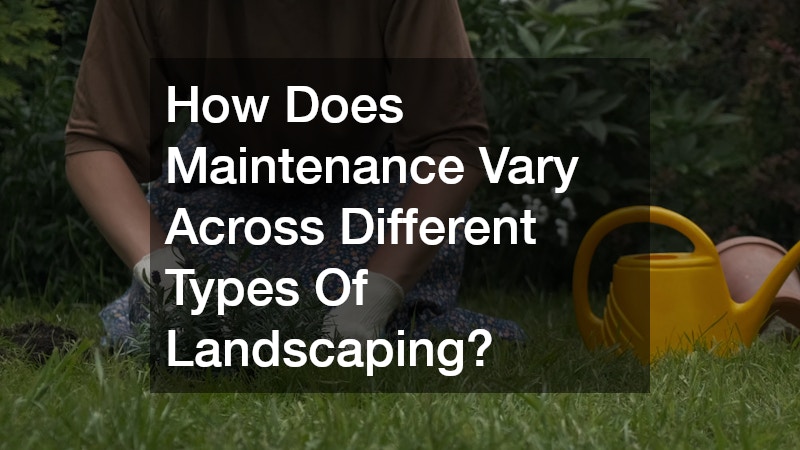Landscaping is an art that blends creativity with functionality, transforming outdoor spaces into areas of beauty and utility. Choosing the right landscaping approach can significantly enhance the aesthetic appeal, increase property value, and create an environment that is both welcoming and sustainable. From lush residential gardens to sophisticated commercial setups, there is an array of landscaping options to suit different tastes and practical needs.
What Are The Different Types Of Landscaping?
Landscaping encompasses a variety of approaches, each designed to achieve a specific look and purpose. While some prioritize visual appeal, others focus on sustainability, water conservation, or structural functionality.
Residential Landscaping
Residential landscaping is the most common type of landscaping, focused on enhancing the home environment. This type often involves creating aesthetically pleasing lawns, flower beds, shrubs, and pathways, as well as integrating functional elements like patios or decks. Homeowners frequently hire landscaping services to handle tasks such as forestry mulching, lawn fertilizers application, and lawn sprinkler repairs.
Commercial Landscaping
Commercial landscaping aims to create an inviting and professional appearance for businesses and public spaces. It often involves larger-scale site work, including the installation of hardscaping elements such as walkways, retaining walls, and parking areas. Companies may utilize rigging rental services to move heavy materials efficiently during installation. Proper commercial landscaping not only improves aesthetic appeal but also enhances safety and accessibility for visitors and employees.
Xeriscaping
Xeriscaping is a type of landscaping specifically designed for areas prone to drought. It emphasizes water-efficient techniques and the use of drought-resistant plants. Xeriscaping requires careful planning to ensure that every plant thrives with minimal water use, reducing reliance on irrigation systems. Lawn sprinkler repairs may still be necessary for surrounding areas, but overall water consumption is significantly lower.
Sustainable Landscaping
Sustainable landscaping integrates environmental stewardship into design practices. This approach focuses on using native plants, recycling organic waste, and minimizing chemical fertilizers. Utilizing resources like a local garden center can provide access to native plant species and sustainable materials. Sustainable landscaping is highly compatible with eco-friendly practices, such as incorporating locally sourced mulch, partnering with a local manufactured stone supplier for durable paths, and applying eco-conscious lawn fertilizers.
Hardscaping
Hardscaping refers to the non-living elements in landscaping, including stone walls, patios, driveways, and walkways. Key materials in hardscaping often come from a local manufactured stone supplier, ensuring durability and local sourcing. Hardscaping can be combined with soft landscaping elements for visual contrast and functional outdoor spaces. Whether using epoxy floor finishes for patios or integrating dump truck rentals for material transport, hardscaping is essential for creating structure and long-lasting design in any outdoor area.
How To Choose The Right Landscaping Type For Your Home?

Selecting the appropriate landscaping type requires careful evaluation of your yard’s characteristics, environmental conditions, and personal preferences. A well-chosen landscape plan can save time, money, and maintenance effort while achieving the desired aesthetic.
Assessing Your Yard’s Condition
Begin by analyzing your yard’s current state, including soil type, sunlight exposure, and topography. Identifying problem areas, such as poorly drained soil or uneven terrain, helps determine whether certain landscaping types like hardscaping or xeriscaping are more suitable. Using forestry mulching services can help clear overgrown areas, creating a clean canvas for your landscaping project.
Understanding Climatic Influences
Climate plays a crucial role in determining suitable landscaping. Xeriscaping is ideal for arid climates, while sustainable landscaping with native plants works well in regions with consistent rainfall. A local garden center can provide insights into which plants thrive in your area, helping you make climate-conscious decisions.
Considering Maintenance Requirements
Different types of landscaping demand varying levels of maintenance. Residential landscapes with lush lawns and flower beds may require frequent lawn fertilizers and sprinkler maintenance, whereas xeriscaped yards need less intensive care. Evaluating your available time and resources ensures that the chosen landscaping style remains sustainable long-term.
Analyzing Budget Constraints
Budget considerations are vital when planning landscaping projects. Incorporating hardscaping elements or using specialty materials from a local manufactured stone supplier can increase costs, while sustainable landscaping practices often reduce ongoing expenses. Renting equipment such as dump truck rentals or rigging rental services, can make large-scale projects more affordable by avoiding permanent machinery purchases.
Aligning With Personal Preferences
Your landscaping should reflect your personal taste and lifestyle. Whether you prefer a tranquil garden, a modern patio, or a drought-resistant yard, selecting the right type of landscaping ensures that the space is both functional and visually appealing. Consulting landscaping services can help integrate your preferences with practical solutions, such as choosing the right epoxy floor finishes for outdoor entertainment areas.
What Is Sustainable Landscaping And How Does It Benefit The Environment?
Sustainable landscaping focuses on reducing environmental impact while maintaining aesthetic appeal. It integrates eco-friendly practices to conserve water, recycle waste, and enhance biodiversity.
Principles Of Sustainable Landscaping
Sustainable landscaping principles include using native plants, minimizing chemical fertilizers, and incorporating energy-efficient irrigation systems. Partnering with a local garden center ensures access to materials and plants that support environmental sustainability.
Water Conservation Techniques
Efficient water use is a cornerstone of sustainable landscaping. Techniques include installing water-saving irrigation systems, collecting rainwater, and designing xeriscaped areas that require minimal watering. Lawn sprinkler repairs can help ensure systems function efficiently, preventing waste and maintaining plant health.
Use Of Native Plants
Native plants are naturally adapted to local soil and climate conditions, making them resilient and low-maintenance. They reduce the need for excessive fertilizers, pesticides, or irrigation, which supports a healthier environment. Sourcing native plants from a local garden center ensures they are suitable for your region and helps create a thriving ecosystem in your yard.
Waste Recycling And Composting
Sustainable landscaping encourages recycling organic waste through composting, reducing landfill contributions. Forestry mulching can be repurposed as mulch, enriching soil fertility and reducing dependency on chemical fertilizers. This practice supports long-term soil health and environmental balance.
Long-Term Environmental Benefits
By implementing sustainable landscaping, homeowners contribute to cleaner air, improved soil quality, and increased biodiversity. Reducing water usage, conserving native habitats, and minimizing chemical input all lead to long-term ecological gains while creating a visually pleasing outdoor environment.
How Is Hardscaping Different From Other Landscaping Types?

Hardscaping focuses on the structural and non-living elements of landscaping, providing stability, function, and durability.
Defining Hardscaping
Hardscaping includes patios, driveways, walkways, retaining walls, and other permanent outdoor structures. It is essential for adding organization and design coherence, complementing soft landscaping elements like plants and flowers.
Key Materials Used In Hardscaping
Materials for hardscaping often include stone, brick, concrete, and epoxy floor surfaces. Utilizing a local manufactured stone supplier ensures material quality and local sourcing. Dump truck rentals may be necessary for transporting heavy materials during installation, making large-scale projects feasible.
Design Elements In Hardscaping
Hardscaping design emphasizes symmetry, texture, and functionality. It integrates paths, seating areas, and water features to create an inviting and structured outdoor space. Thoughtful hardscaping can significantly enhance the usability and visual appeal of any yard.
Benefits Of Incorporating Hardscaping
Hardscaping provides durability, low maintenance, and year-round visual structure. It complements soft landscaping by offering contrast and focal points while improving accessibility and outdoor living functionality.
Considerations When Planning Hardscaping Projects
Planning a hardscaping project requires assessing space, selecting appropriate materials, and estimating costs. Incorporating rigging rental services can simplify the handling of large stones or heavy equipment, and consulting professional landscaping services ensures a cohesive design.
What Is Xeriscaping, And Is It Suitable For Your Yard?
Introduction To Xeriscaping
Xeriscaping focuses on drought-resistant plants, efficient irrigation systems, and minimal water usage. It reduces environmental impact while maintaining a visually appealing landscape.
Key Benefits Of Xeriscaping
Benefits include lower water bills, reduced maintenance, and a resilient landscape that thrives under arid conditions. Combining xeriscaping with sustainable landscaping principles maximizes environmental efficiency.
Ideal Conditions For Xeriscaping
Xeriscaping works best in regions with limited rainfall or areas where water conservation is a priority. It is compatible with various soil types and can integrate with hardscaping elements to enhance aesthetics.
Types Of Plants Used In Xeriscaping
Common plants include succulents, ornamental grasses, and native flowering species. Local garden centers provide suitable plant options for your region, ensuring adaptability and long-term success.
Maintenance Tips For Xeriscaped Yards
Maintenance involves occasional irrigation, pruning, and soil amendments. Using lawn fertilizers selectively and repairing irrigation systems as needed ensures plant health without excess water use.
How Can I Incorporate Water Features Into My Landscaping?

Water features, such as ponds, fountains, and waterfalls, add tranquility and elegance to any landscape.
Types Of Water Features
Popular options include small backyard fountains, garden ponds, and cascading waterfalls. Each type adds a unique aesthetic and auditory appeal to the yard.
Benefits Of Water Features
Water features enhance relaxation, attract wildlife, and increase property value. They serve as focal points that complement other landscaping elements, including hardscaping and sustainable plantings.
Designing Water Features For Small Yards
In compact spaces, vertical waterfalls or small ponds maximize impact without overwhelming the area. Thoughtful placement ensures integration with surrounding plants and structures.
Maintenance Of Water Features
Regular cleaning, water treatment, and equipment checks maintain water quality. Lawn sprinkler repairs or irrigation adjustments may be necessary to prevent excess water runoff from surrounding areas.
What Are The Benefits Of Using Native Plants In Landscaping?
Native plants support local ecosystems while providing aesthetic and practical advantages.
Definition And Examples Of Native Plants
Native plants naturally occur in a specific region. Examples include local wildflowers, shrubs, and trees that thrive without intensive care, making them ideal for sustainable landscaping.
Environmental Benefits
Native plants reduce the need for irrigation, fertilizers, and pesticides. They enhance soil health, support pollinators, and contribute to ecological balance.
Ease Of Maintenance
Native plants require less upkeep than exotic species. Minimal watering, pruning, and soil amendments are needed, making them cost-effective and environmentally friendly.
Habitat Creation For Wildlife
Incorporating native plants attracts birds, insects, and other wildlife, enriching biodiversity in your yard. This aligns with sustainable landscaping principles while enhancing the garden’s vibrancy.
Cost-Effectiveness Of Native Plants
Using native plants reduces long-term maintenance costs, including water usage, fertilizer application, and pest control. Local garden centers often supply these plants at reasonable prices.
How Do I Create A Landscape Design Plan?
A landscape design plan organizes ideas, space, and resources to achieve the desired outcome efficiently.
Defining Your Landscape Goals
Identify objectives such as aesthetics, functionality, or environmental sustainability. Knowing your goals guides plant selection, hardscaping, and water feature integration.
Assessing Your Yard’s Layout
Measure your space, noting existing structures, slopes, and sunlight patterns. Site work may include leveling, grading, or clearing overgrown areas using forestry mulching.
Choosing The Right Plants And Materials
Select plants suitable for your climate and yard conditions. Materials like epoxy floor coatings for patios and stone sourced from a local manufactured stone supplier complement the plant selections.
Consulting With A Professional Landscaper
Professional landscapers provide expertise in plant care, structural design, and installation logistics. Their experience ensures that your landscaping vision becomes a functional and aesthetically pleasing reality.
How Does Maintenance Vary Across Different Types Of Landscaping?

Maintenance needs differ significantly depending on the landscaping type chosen.
Maintenance Requirements For Residential Landscaping
Residential landscaping requires regular lawn mowing, fertilization, and irrigation upkeep. Lawn sprinkler repairs and the application of lawn fertilizers are essential for maintaining lush greenery.
Commercial Landscaping Maintenance Essentials
Commercial landscapes demand consistent upkeep, including pruning, site work, and hardscape maintenance. Hiring landscaping services ensures the property remains attractive and safe for visitors.
Sustainable Landscapes: Minimal Upkeep
Sustainable landscaping emphasizes low-maintenance practices like native plant use, efficient irrigation, and waste recycling. Proper planning reduces the need for ongoing intervention, making it ideal for eco-conscious homeowners.
Special Considerations For Hardscape Maintenance
Hardscaping requires inspection and cleaning of surfaces, including patios, stone pathways, and epoxy floor coatings. Durable materials reduce long-term upkeep, but occasional repairs may involve rigging rental services or dump truck rentals for larger projects.
What Role Does Landscape Lighting Play In Yard Design?
Landscape lighting enhances the beauty, safety, and functionality of outdoor spaces.
Types Of Landscape Lighting
Options include pathway lights, spotlights, and accent lights. Each type highlights specific features, from plant arrangements to hardscaping elements, adding depth and dimension.
Benefits Of Effective Lighting
Proper lighting improves safety, extends usable outdoor hours, and accentuates architectural and natural features. Energy-efficient fixtures reduce power consumption while providing reliable illumination.
Energy-Efficient Lighting Options
LED and solar-powered lights provide long-lasting illumination with minimal environmental impact. These options align with sustainable landscaping practices, reducing energy costs while maintaining aesthetic appeal.
Placement And Design Considerations
Strategic placement highlights focal points and prevents glare or shadows. Combining lighting with other landscaping elements, such as water features or native plant clusters, creates a harmonious outdoor environment.
Understanding the different types of landscaping allows homeowners to create outdoor spaces that are beautiful, functional, and sustainable. By evaluating yard conditions, climate, maintenance needs, and personal preferences, you can choose the landscaping approach that fits your lifestyle. Incorporating sustainable practices, hardscaping, xeriscaping, and native plants ensures long-term environmental benefits, while landscape lighting and water features enhance aesthetics and usability.
